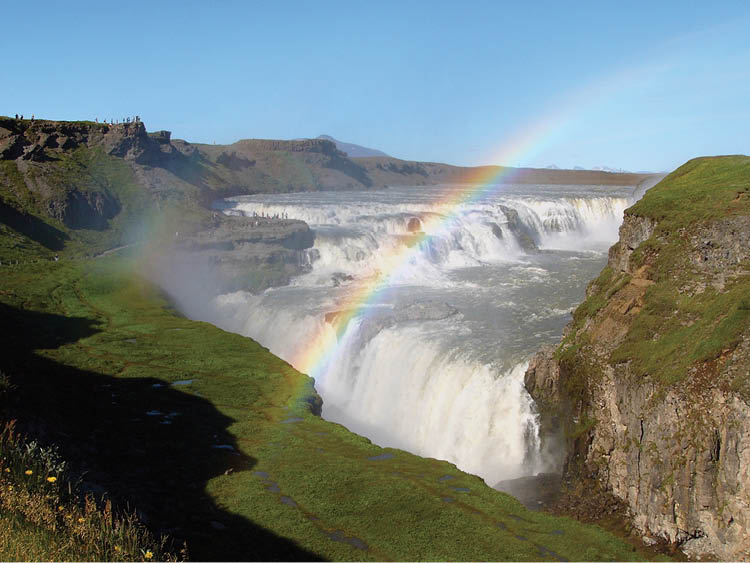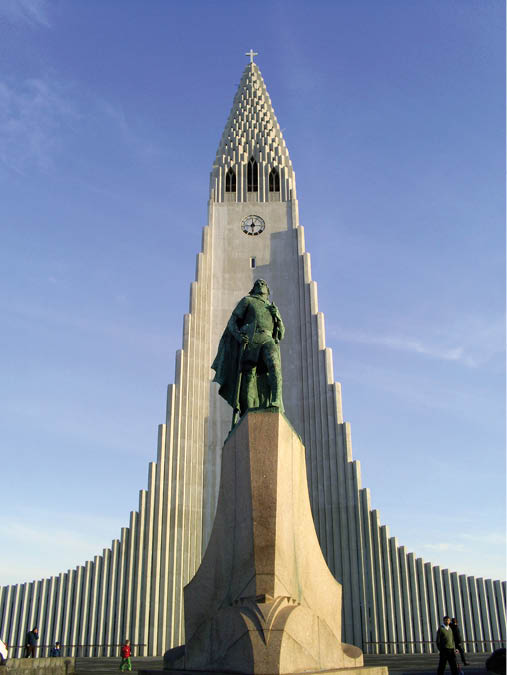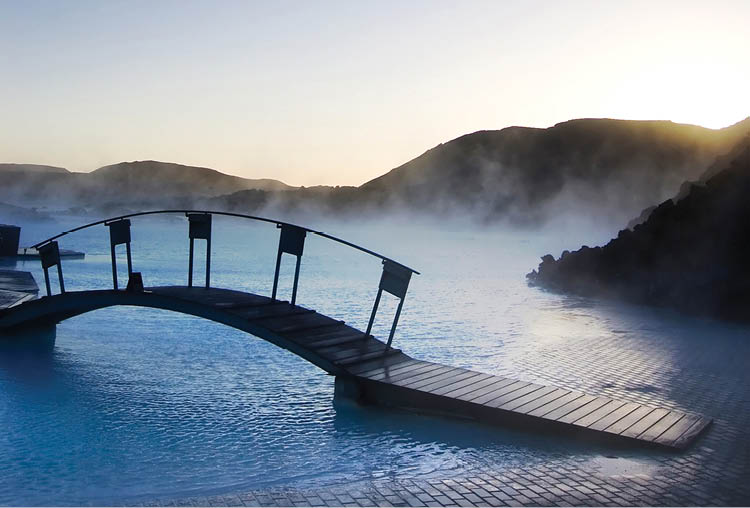Iceland


Gullfoss is one of many spectacular waterfalls in Iceland.
The island nation of Iceland is an isolated place of stark beauty. Deep fjords indent its rugged coastline, volcanic peaks rise above silent expanses of ice and snow, and glacial meltwater feeds thundering waterfalls which spill into river gorges. The opening scenes of Ridley Scott’s Prometheus were filmed in Iceland and featured Dettifoss – the most powerful waterfall in Europe. Iceland also contains vast fields of lava rock and rolling plains of soft, dusty sand which served as a lunar-like landscape for NASA astronauts training for their first moon landing.
Lying in the mid-Atlantic just south of the Arctic Circle, Iceland is geographically a young basalt plateau (a raised part of the Earth’s crust), which straddles the Mid-Atlantic Ridge (a volcanic submarine mountain range). Because Iceland sits atop a mantle plume (hot spot), the country has about 200 volcanoes, many of which are active, and an abundance of hotsprings, which provide a cheap and non-polluting source of heating for homes and outdoor swimming pools.
Iceland is Europe’s second largest island (after Great Britain) and over half of the country’s total population of 300,000 live in the capital of Reykjavik, which is an Old Norse name meaning Smoky Bay, so named for the misty geothermal steam rising from the water.

The Leif Ericsson statue in front of Hallgrimskirkja in Reykjavik.
First visited by Irish monks, Iceland was settled by Vikings in the mid-9th century. The Norse chieftain Eric the Red arrived a century later, having left Norway with his exiled father. They sailed to Iceland, where his son Leif Ericsson was born. Others seeking sanctuary in Iceland have included the American chess champion Bobby Fischer, who defeated the Soviet Union’s Boris Spassky in a celebrated chess match held in Reykjavik in 1972. Icelanders, who are passionate about chess, returned the favour in 2005 by granting citizenship to their adopted national hero.
Fischer died in Reykjavik in 2008, the same year Iceland’s rapidly expanding economy nearly collapsed amid the global financial crisis. The country’s currency went into a freefall and the Icelandic government, facing national bankruptcy, turned to oil-rich Russia for an emergency loan. This is not the first time Iceland has faced looming disaster. In the 17th and 18th centuries, Danish trade monopolies and repeated pirate raids ruined the country’s economy, while epidemics and volcanic eruptions killed many.
After centuries of poverty and hardship, the 19th century brought a rebirth of national culture and a longing for independence. Icelandic literature flourished just as Old Norse literature had until the 13th century, when Iceland came under Norwegian, then Danish, rule. In 1918 Iceland became a sovereign state in union with Denmark, but this agreement was peacefully terminated in 1944 when Icelanders voted to become an independent republic.
Iceland’s parliament had first convened at Thingvellir in the year 930, making it the world’s oldest. The country’s language is so well preserved that modern Icelandic is virtually the same as Old Norse, which is why Icelandic schoolchildren can read sagas written in medieval times.
Iceland’s isolated location has also resulted in animal breeds unique to these shores. Icelandic sheep, brought by Vikings, grow fleece in two layers – a long, outer layer (tog) and a short, fine underhair (pel). The early Icelanders spun the tog into strong cord for weaving, while the finest wool (similar to mohair) was used for lacy shawls and embroidery. The Icelandic horse, also brought by the Vikings, is a small, hardy animal with a heavy winter coat and was bred for farm work in harsh conditions. A friendly, easy-to-handle breed with no diseases, the Icelandic horse is protected by a law that prohibits the importing of horses into Iceland.
With limited agricultural land, Iceland’s major industry has always been fishing. The abundance of fish also attracts whales, which feed in local waters from May through September. Seabirds such as puffins and kittiwakes nest in sea cliffs, their rocky ramparts washed by waves that have eroded nearby sea stacks into shapes with names such as The Giant and The Hag – inspired by Old Norse legends.
Modern artists include the avante-garde singer-songwriter Bjork, and the post-rock band Sigur Ros, who have performed on the television show Game of Thrones, scenes from which were shot in Iceland near Lake Myvatn. The band’s recording studio is located in the coastal town of Mosfellsbaer, about ten miles north of Reykjavik, where they converted a drained, abandoned swimming pool (sundlaug in Icelandic) into a studio. The textile company Alafoss was founded here in 1896, taking its name from the local waterfall which provided energy for spinning wool.

The fishing port of Husavik is also a whalewatching base.
Iceland’s climate is similar to the Alaska Peninsula. Summers are warm and the sun barely sets in June and July. English is the second language and spoken by nearly all Icelanders. Iceland’s currency is the krona. Approximate exchange: $1US = 130 ISK; £1GBP = 200 ISK.
Renting a car is one way to see the attractions near Reykavik. Traffic jams are rare and the roads are well maintained. Speeds are posted in kilometres and driving is on the right. Rentals start at about $85 a day and the best rates are obtained by booking online.
Shopping items to look for include woven and knitted textiles. Iceland is famous for its Lopi wool cardigan – made with a bulky weight yarn and featuring a distinctive circular yoke and patterned borders. The Alafoss factory outlet in Mosfellsbaer carries beautiful Lopi sweaters in a range of colours and patterns, as well as sheepskin hats, gloves and other items.

The geothermal waters of Blue Lagoon near Reykjavik.
Reykjavik is Iceland’s capital, industrial hub and largest port. The city centre is compact and home to the nation’s parliament (Althing), university, national theatre and national museum. A new concert hall and conference centre stand along the harbourfront. Notable monuments include a statue of Leif Ericsson given by the US Congress to the people of Iceland in 1930 to commemorate the 1,000th anniversary of the founding of the Althing. This statue stands in front of Hallgrimskirkja church, which rises above the Reykjavik skyline like a pinnacle of ice.
The dramatic countryside surrounding Reykjavik is a short drive away. Area attractions include the famous Blue Lagoon geothermal spa, situated in a field of lava rock on Reykjanes, which is a peninsula with active volcanism beneath its surface. A large, shallow swimming pool was built beside a geothermal power station to tap into its hot and mineralized water – a mixture of silky white silica mud and blue-green algae. The pool’s steaming hot, sulphuric water is not only relaxing and invigorating, its therapeutic qualities are recognized by Iceland’s ministry of health in the treatment of various skin conditions, such as psoriasis, eczema and acne. Facilities at the spa include bathing suit rental, dressing rooms, showers, a cafe and gift shop.
Akureyri (pop. 16,000) is the main town of northern Iceland and lies at the head of Eyjafjord, the longest fjord in Iceland. The cruise dock is within walking distance of town, which is known for its Botanical Gardens, galleries and souvenir shops. Excursions at Akureyri include a visit to spectacular Godafoss Waterfall, the nature baths at Lake Myvatn (known for its abundance of bird life) or a flight to Grimsey Island (pop. 100), which lies on the Arctic Circle and is edged with sea cliffs. Whalewatching excursions originate in the nearby fishing port of Husavik in Skjalfandi Bay.
The small port of Isafjordur (pop. 3,000) occupies a spit of land in Skutulsfjordur, one of several fjords found in mountain-ringed Isafjordur. Home to historic merchant houses and fishermen huts, the town is a 30-minute boat ride to the seabird colonies of Vigur Island.
Seydisfjordur (pop. 750) lies nestled at the base of two mountains below a valley carved by a river that cascades over 25 waterfalls into a lagoon at the head of the fjord. The cruise dock is in the centre of town and features traditional wooden buildings. Ferries connect this eastern Iceland port with continental Europe.

Djupivogur provides access to Jokulsarlon Glacier Lagoon.
The coastal village of Djupivogur, set amid scenic mountains and fjords, offers shore excursions to Glacier Lagoon. Formed by the retreating Jokulsarlon Glacier, this famous lagoon began forming in the 1930s. As the glacier tongue retreats, it calves ice into the lagoon, and these floating ice sculptures can be viewed on 40-minute boat tours. The lagoon was featured in the James Bond movie Die Another Day.